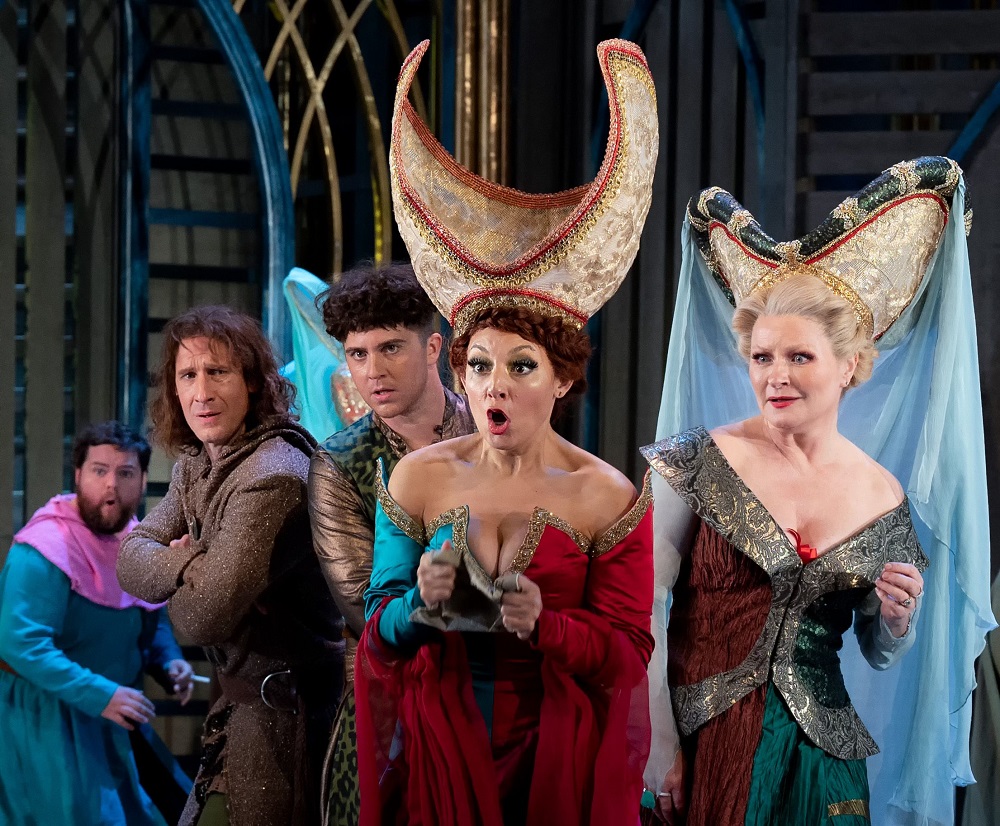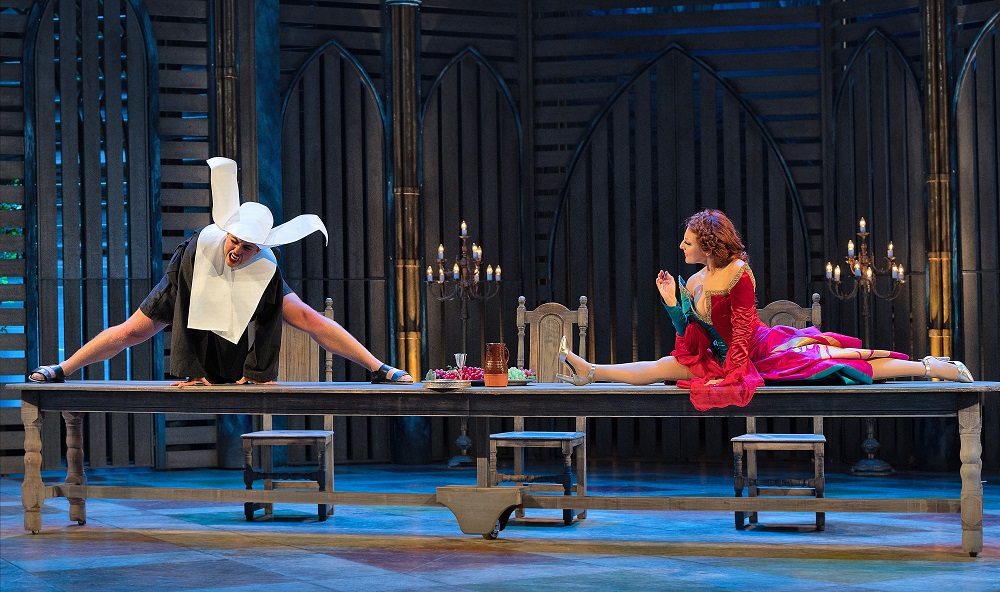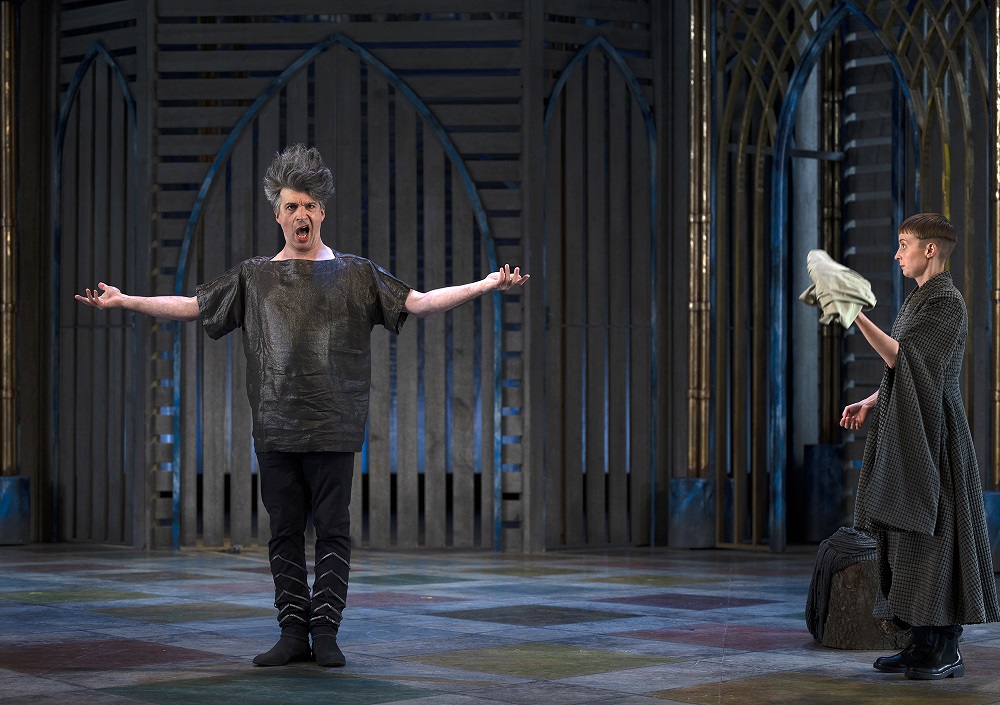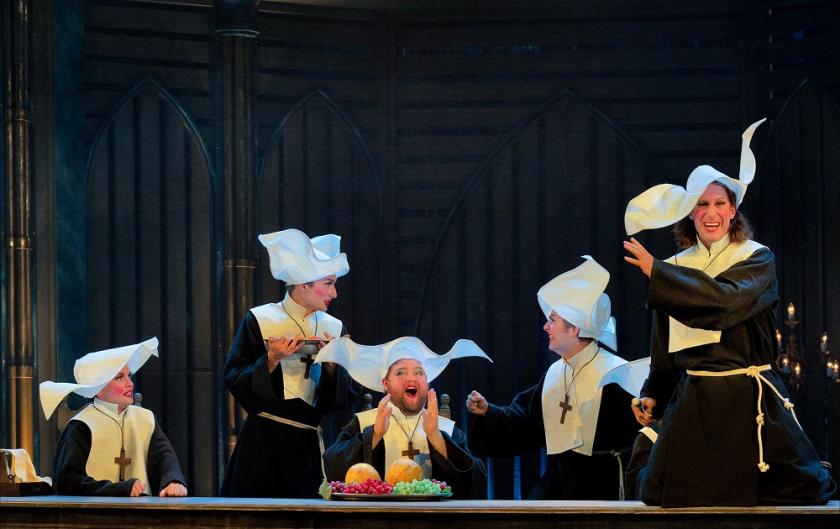Play it straight and you’ll get more laughs: that’s the standard advice on great operatic comedies like the masterpieces of the Gilbert & Sullivan canon, Britten’s Albert Herring, Verdi’s Falstaff, Puccini’s Gianni Schicchi. In comparison, for all its musical sparkle, Rossini’s Le Comte Ory may have amusing situations, but zero psychological insight into the characters, and plods along for the first half of Act One with very little intrinsic humour. So only the pious should have an issue with Cal “One Man, Two Guvnors” Crystal for camping and vamping it up; and what a gift he has in a brilliant line-up of soloists and a young chorus who can go the whole hog with him even as they sing in high style.
Last night’s performance, the penultimate, was the first of two with Robert Murray, vintage tenor with a gift for comedy, replacing Jack Swanson as the licentious Count Ory who’s determined to seduce the Countess Adèle (all the women have taken up chastity while the real men are away at the Crusades). Murray may not be the born Rossini tenore di grazie of the kind indicated by Swanson’s biography, but he carries the vocal pyrotechnics with dramatic panache. He also looks as if he’s always been part of the ensemble – he’s used to Garsington operetta – as he juggles oranges, does the quickest of changes into Groucho Marx glasses and eyebrows and throws himself, though presumably with choreographic care, into the Act Two antics where he and his men disguise themselves as nuns to wheedle their way into the castle where Adèle and female company are sequestered.  That one-act plot, such as it is, was Rossini’s original idea; to add a kind of “prequel” setting up the characters and requiring Ory to adopt another pose as an hermetic expert on amatory matter, might have been a mistake. Musically there’s plenty of lively writing for the chorus; one of the two 24-strong groups at Garsington is superb from the start, and McCrystal gives them Spamalot-meets-1200-headdress costumes (by Takis, in garish accord with his open set) as well as stylised mugging roles as individuals (though the gag of the Snow White witch with apple shouldn't have lasted beyond the first scene).
That one-act plot, such as it is, was Rossini’s original idea; to add a kind of “prequel” setting up the characters and requiring Ory to adopt another pose as an hermetic expert on amatory matter, might have been a mistake. Musically there’s plenty of lively writing for the chorus; one of the two 24-strong groups at Garsington is superb from the start, and McCrystal gives them Spamalot-meets-1200-headdress costumes (by Takis, in garish accord with his open set) as well as stylised mugging roles as individuals (though the gag of the Snow White witch with apple shouldn't have lasted beyond the first scene).
It does, though, take an awfully long time before we meet heroine Adèle. And then things really spark with petite American soprano Andrea Carroll going against the grain of the languishing virgin (as Rossini’s music does too) by putting her yoga training to good use in some extraordinary collapses (in Act Two this Adele irritates Ory and her companion Ragonde – true contralto Patricia Bardon (pictured above on the right with Carroll's Adèle centre, Jacques Imbrailo and the first Ory, Jack Swanson), another stylish singer totally at ease on stage – with her agility, which they imitate in vain, and ends up doing the splits on the dining table, pictured below). Vocally she’s a dream lyric coloratura, singing so many roles at the Vienna State Opera; Garsington could build an Ariadne auf Naxos around Carroll's putatively acrobatic Zerbinetta.  No-one else comes off second best to these two. Jacques Imbrailo and Joshua Bloom kick off with spoken comedy business at the start – this Raimbaud thinks he’s supposed to be Rambo, and Bloom acts out anger at not getting the principal role because of the three-in-a-bed scene – and provide stentorian backbone in solos and ensembles (the one which kicks off the Act One finale, adapted from the “Gran Pezzo Concertato” in Rossini’s previous opera, Il viaggio a Reims, gets a round of applause when it blazes into ensemble a cappella at the revelation of Ory’s disguise – a bit like “Hail, Poetry” in The Pirates of Penzance. We’re simply thrilled to be hearing full-throttle choruses again, anyway). Katie Bray (pictured below with Bloom) is vibrant and delicious in the principal-boy role of Isolier the page – yes, this is pantoland – and blends beautifully in duet with Carroll.
No-one else comes off second best to these two. Jacques Imbrailo and Joshua Bloom kick off with spoken comedy business at the start – this Raimbaud thinks he’s supposed to be Rambo, and Bloom acts out anger at not getting the principal role because of the three-in-a-bed scene – and provide stentorian backbone in solos and ensembles (the one which kicks off the Act One finale, adapted from the “Gran Pezzo Concertato” in Rossini’s previous opera, Il viaggio a Reims, gets a round of applause when it blazes into ensemble a cappella at the revelation of Ory’s disguise – a bit like “Hail, Poetry” in The Pirates of Penzance. We’re simply thrilled to be hearing full-throttle choruses again, anyway). Katie Bray (pictured below with Bloom) is vibrant and delicious in the principal-boy role of Isolier the page – yes, this is pantoland – and blends beautifully in duet with Carroll.  Rossini saves the highlight, though, for near the end: a trio of confusion, delectably orchestrated, when the Count abandons his wimple and creeps into Adèle’s bedroom where Isolier is already installed. Up to this point, McCrystal’s humour is fun, but not quite of the laugh-until-you-cry variety he unleashed in the ENO Iolanthe. This above all is the scene which fits most perfectly his definition of the “rubber chicken served up on a gold plate”.. Adele constructs a dummy out of pillows and linen, Ory falls both for and on it (Murray hilarious at this point), and then the lady and the page use hands on sticks to fondle the fooled Count all over.
Rossini saves the highlight, though, for near the end: a trio of confusion, delectably orchestrated, when the Count abandons his wimple and creeps into Adèle’s bedroom where Isolier is already installed. Up to this point, McCrystal’s humour is fun, but not quite of the laugh-until-you-cry variety he unleashed in the ENO Iolanthe. This above all is the scene which fits most perfectly his definition of the “rubber chicken served up on a gold plate”.. Adele constructs a dummy out of pillows and linen, Ory falls both for and on it (Murray hilarious at this point), and then the lady and the page use hands on sticks to fondle the fooled Count all over.
The music is almost lost here in gales of laughter, but Valentina Peleggi goes on winning jewelled colours and phrases from the wonderful Philharmonia in the pit. She’s another revelation in what is an evening of unadulterated pleasure, if you let yourself go. Fortunately it’s being or has been filmed, so a wider audience should get to share in the fun. There’s nothing quite like sharing in the mirth live, though, and how we need a good laugh right now.















Add comment